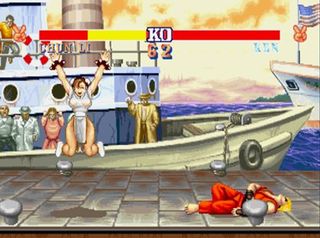It’s strange how one seemingly innocuous decision in history can change everything. When Capcom was considering a sequel to its minor 1987 hit Street Fighter, the plan was to make a traditional side-scrolling beat-‘em-up called Street

Fighter ’89. Eventually that plan was dropped in favour of a game which followed the original’s one-on-one combat style, and the scroller was instead released as Final Fight. If Haggar’s first adventure in vigilante mayordom had become the hit it did while labelled as part of the core Street Fighter series (it has always been considered as existing in the same universe) then we may never have seen a Street Fighter II appear in the form that it did. And although we we may never have known it, we as gamers would have been much, much worse off as a result.
Videogames you see, wouldn’t be what they are without Street Fighter II. When the game pounded its way into arcades in 1991, it brought about a change in gaming that echoed through every darkened nook and cranny of the industry and theculture of players, and which is still drowning us happily in its tsunami today. While basic one-on-one fight games such as IK+ and Yie Ar Kung Fu had existed before, the jump between those and Street Fighter II was akin to the difference between an original Model-T Ford and an F-1 car. This long after the game’s release, it’s easy to forget how fundamentally it changed things, but in a staggering number of ways it simultaneously pioneered and defined what the fighting genre is today.

While the original Street Fighter provided the player with a choice of two characters (Ryu and Ken, naturally), Street Fighter II brought a then-mammoth roster of eight to the table. Even more importantly, the fighters available were all unique in their capabilities and weaknesses, and had a variety of wildly differing but well-balanced special moves at their disposal. These moves were made much easier to pull off than in the original Street Fighter, opening up a vastly deep and varied game, and bringing a level of complexity and skill to the old face smashing that no-one had ever seen before.

And most vitally of all, Street Fighter II invented combos. Read that sentence back for a second and then let its significance sink in. The most fundamental building block of the fighting game came from Street Fighter II, and without it, who knows where the genre would be now. The phenomenon originally came about as the result of a programming glitch which allowed standard moves to be quickly cancelled into specials (See the modern SF terminology beginning to appear already?) to bring about unblockable strings of hits. Upon realising that players had uncovered the exploit, Capcom deigned to leave it in because of the brilliant gameplay possibilities it afforded, and began to build later games around the concept. Thus, fighting games as we know them were born. And that brings us onto the next major significance of the Street Fighter series. Its symbiosis with its community.
Videogames you see, wouldn’t be what they are without Street Fighter II. When the game pounded its way into arcades in 1991, it brought about a change in gaming that echoed through every darkened nook and cranny of the industry and theculture of players, and which is still drowning us happily in its tsunami today. While basic one-on-one fight games such as IK+ and Yie Ar Kung Fu had existed before, the jump between those and Street Fighter II was akin to the difference between an original Model-T Ford and an F-1 car. This long after the game’s release, it’s easy to forget how fundamentally it changed things, but in a staggering number of ways it simultaneously pioneered and defined what the fighting genre is today.

While the original Street Fighter provided the player with a choice of two characters (Ryu and Ken, naturally), Street Fighter II brought a then-mammoth roster of eight to the table. Even more importantly, the fighters available were all unique in their capabilities and weaknesses, and had a variety of wildly differing but well-balanced special moves at their disposal. These moves were made much easier to pull off than in the original Street Fighter, opening up a vastly deep and varied game, and bringing a level of complexity and skill to the old face smashing that no-one had ever seen before.

And most vitally of all, Street Fighter II invented combos. Read that sentence back for a second and then let its significance sink in. The most fundamental building block of the fighting game came from Street Fighter II, and without it, who knows where the genre would be now. The phenomenon originally came about as the result of a programming glitch which allowed standard moves to be quickly cancelled into specials (See the modern SF terminology beginning to appear already?) to bring about unblockable strings of hits. Upon realising that players had uncovered the exploit, Capcom deigned to leave it in because of the brilliant gameplay possibilities it afforded, and began to build later games around the concept. Thus, fighting games as we know them were born. And that brings us onto the next major significance of the Street Fighter series. Its symbiosis with its community.

